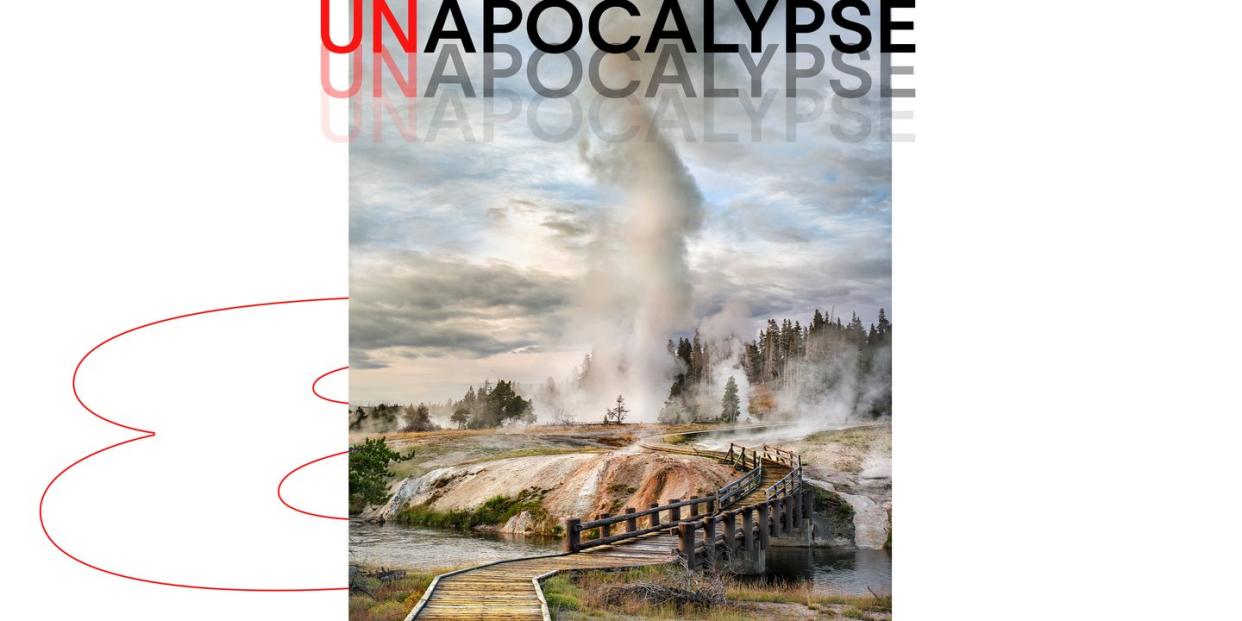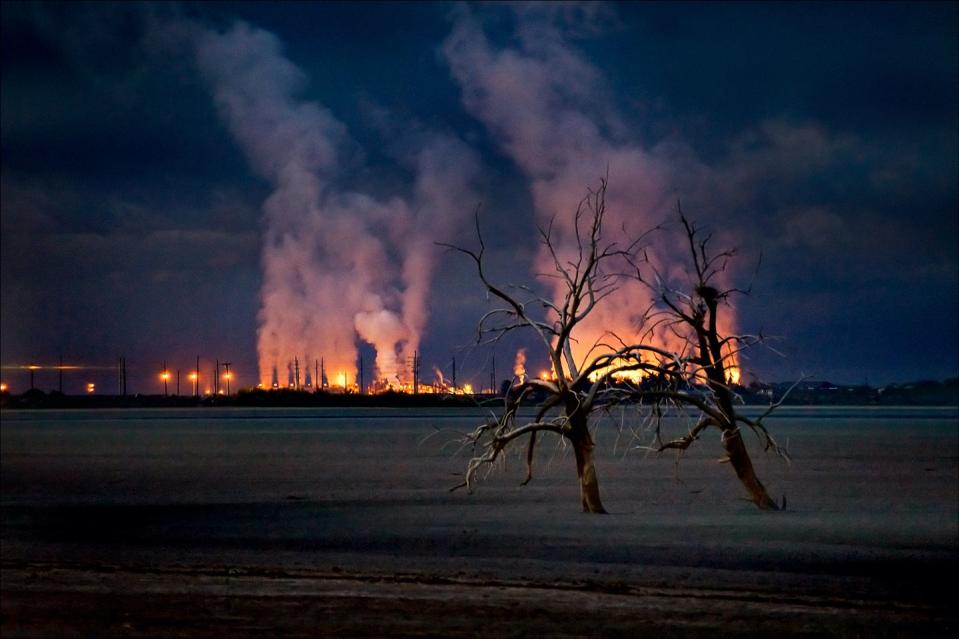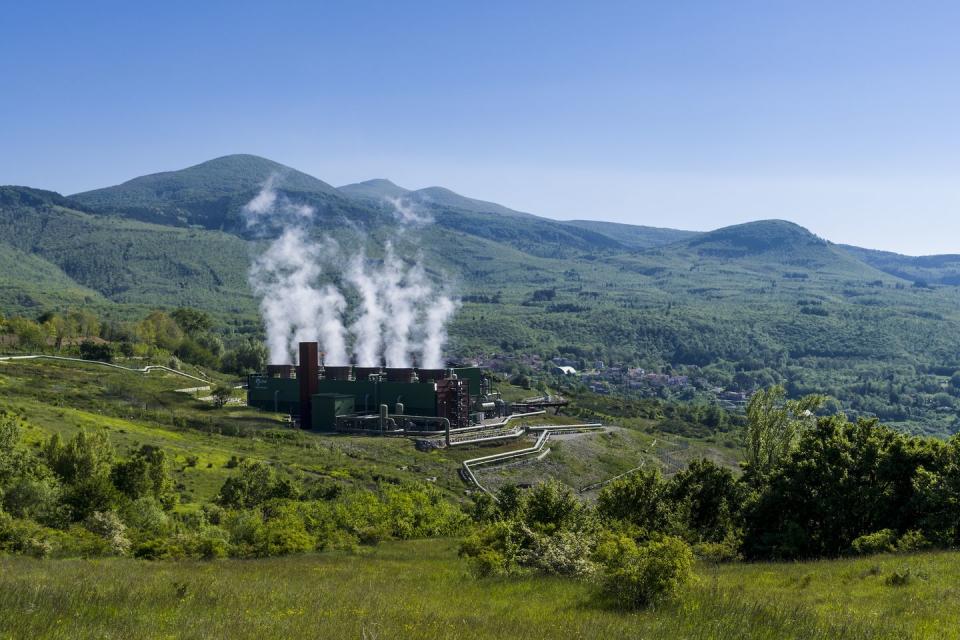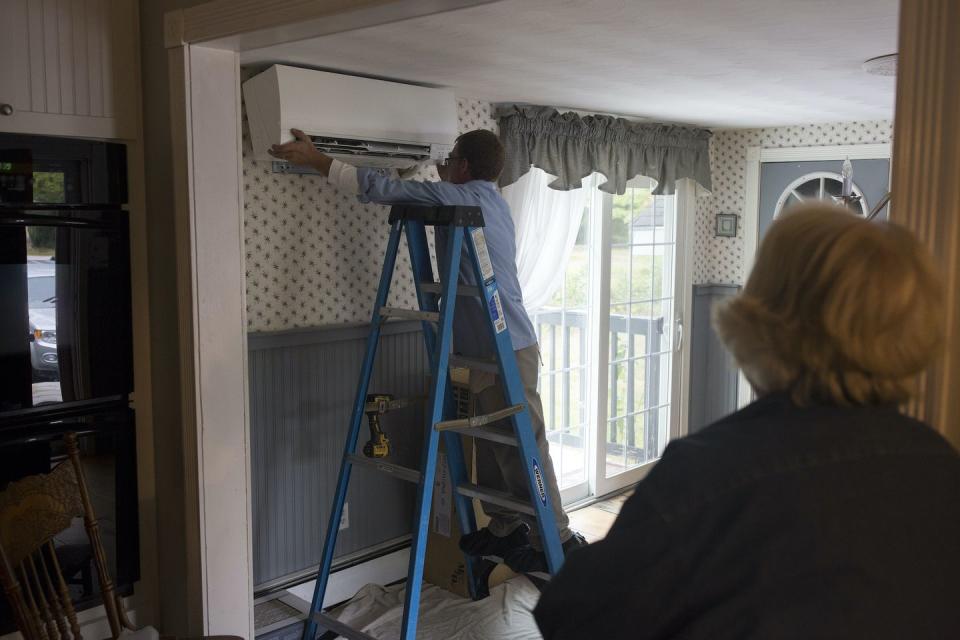The Energy of the Future Is Thousands of Years Old

We’ve heard an awful lot of awful news when it comes to the climate crisis. But there are also very smart people working on clever ways for us to dig ourselves out of the hole we’re in. UNAPOCALYPSE is a series from Esquire that highlights ways humans can mitigate and adapt to the damage caused by a changing climate.
Geothermal energy is both one of civilization’s oldest technologies and, here in modernity, positioned right on the cutting edge. Humans in China and Europe have harnessed hot springs for thousands of years, while the oldest geothermal plant was built in 1911 at Lardarello, Italy. Nowadays, the United States is the world’s number-one producer of electricity from geothermal sources, but it still makes up just 0.4 percent of our total electricity generation, and 2 percent of renewables.
There’s a lot of room to grow, because conventional geothermal technology has required very particular topography. That’s why the vast majority of geothermal electricity generation happens out West, particularly in Nevada and California. (In general, it’s been in the kind of landscapes where you’d find geysers and hot springs.) But as we develop what’s called “enhanced geothermal systems” (EGS), we can start to exploit the energy underfoot across the country, all with a carbon impact that is vanishingly small compared to most sources we depend on now. It’s clean, and unlike solar or wind, geothermal provides what’s called “baseload power.” It’s cranking 24/7.
To learn more about where geothermal is and where it’s going, I called up Lauren Boyd, who runs the EGS program at the United States Department of Energy. Along with the major technological gains we’re making on the power side, the recently passed Inflation Reduction Act also set aside $500 million in tax breaks for Americans who decide to install heat pumps for their house. As Boyd explained in our conversation (edited for length and clarity), the pumps allow people to heat and cool their homes without oil or gas, a potential revolution for consumers.
What is the source for the energy that we're trying to harness this way?
It’s heat that is being replenished constantly from the decay of naturally occurring elements in the Earth's interior that got there when our planet formed—heat that's been radiating for the last 4 billion years or so. What we're doing with geothermal is just taking advantage of that heat that's stranded in the subsurface beneath our feet and using it for beneficial power.
What are the mechanics of pulling this heat and energy out of the ground?
It can span a lot of uses. On the low end of the temperatures that you might see in the subsurface, 10 feet below our feet, we can use it for heating and cooling our homes. But then as you move deeper, you're getting higher and higher temperatures as you're getting closer to those heat sources, and in that case, we can actually produce power. You need higher temperatures, generally, to produce power, although there are lots of really significant advances in power production from lower and lower temperatures as the years go on.
When we're thinking about producing power that goes through the grid—that helps us turn on our lights—the way that we do that is, first, we need to get into the subsurface. And so we drill wells, and those are basically on the order of 8 to 13 inches in diameter. Picture a big drinking straw that we drill into the subsurface, and that gets us closer to the hot fluid that we want to harness to produce our power. And then we'll pump that fluid up to the surface, and then it can be used in a couple of different types of power plants.

If it's a really hot resource, the water is going to just turn to steam as soon as it comes to the surface, and we use a special type of power plant for that called a flash power plant. If the water is at lower temperatures, then we'll use what we often call a binary power system. And basically what it does is, we bring up hot fluid to heat up another working fluid, all of which is enclosed in piping, and that working fluid might boil at a lower temperature, and that is then used to turn a turbine and generate power. So it all comes back to turning a turbine and a generator. Then we take the [subsurface] fluid, it cools off, and then we inject it back in.
Do we face any emissions issues when drilling these wells? Are there, say, methane issues?
Generally with geothermal, we are never having methane emissions. In some cases, just because of the types of environments that geothermal exists in, hydrogen sulfide is a gas that can be released during drilling. But that's all mitigated and abated during drilling in very careful and regulated ways.
How do the emissions compare to solar or wind?
There's no emissions at all from a binary power plant, which are the majority of the power plants across the world, from the actual power process. Then there’s the lifecycle emissions, which are calculated based on the entirety of the supply chain. When you start building your geothermal power plant, what does it take to generate the steel that becomes the casing that we put in our well bores? What does it take to build the cement that you put into our power plant? I don't have it at the tip of my tongue here, but I think that's important to keep in mind. Because solar's not producing any emissions at all when it's operating, but shipping the panels, et cetera—all renewables are producing some emissions.
I understand that right now, it's pretty regional as a power source—it’s concentrated mostly in the western United States. Is that because of our current technological capabilities?
Conventional geothermal—which is what you see when you see hot springs, when you go to Iceland, when you go to Yellowstone—exists in specific regions. They’re delineated by where there's enough heat and fluid already underground, and where there are enough pathways for that fluid to flow in order to create these natural reservoirs. So we have around 3.6 gigawatts installed in the United States. That comes from the geographic regions where the resources exist. California and Nevada, for example, have tremendous resources. Nevada has more geothermal than many countries do, and they contribute more than 90% of the geothermal power that's generated in the U.S. But there are also power plants in Utah and Oregon, New Mexico, Idaho, Alaska, and Hawaii.
The promise for moving geothermal east lies in the technology that I specialize in, which is enhanced geothermal systems. You're basically creating a man-made version of a natural system, because there's heat everywhere. So the deeper we drill, we can get to that heat. We just need to add those other two variables: you need that heat, you need fluid, and you need pathways for fluid to flow. And so the idea with EGS is that we can produce geothermal power in the eastern U.S., where none currently exists, if we're able to add that fluid to the subsurface, where there's hot rock.

I've also read some stuff about new drilling techniques that would allow us to drill much farther down, this gyrotron thing that they're doing at MIT. Would that also expand the geographic viability?
In drilling, time is money. So if you drill faster, you're reducing your costs significantly. When we use a drill rig for our operations, it can be around $30,000 a day just for daily operations of the rig, and we'll usually need a rig for at least a month. One project that I manage, we were able to drill our well in half the time that we expected. So that's a big savings of money, right?
We're doing a lot of work in improving efficiency of drilling right now because the geothermal industry has some challenges that are unique. The oil and gas industry has drilled thousands of wells a year, and we drill 10 to 20. There've been a lot of advances in technology for oil and gas environments that aren't exactly applicable to us, because we work in different rock, we work in really higher temperatures. There are some technologies that can be adapted for our environments: for those high temperatures, for these really hard, abrasive rocks, and different fluids and such. But that opportunity is significant, because as I said, drilling can be quite expensive. In fact, it's around 50 percent of the development costs of geothermal in general.
We have had advancements in drilling, from how can we develop better bits, how can we develop better motors. Because basically you need a motor to steer your drill bit and to be able to collect data down a hole, which helps us drill better, be more precise in what we're doing. And so we're funding within all of those spaces, and there are some other parts of the Department of Energy that are funding really neat and very, very cutting edge projects, like you mentioned, that are looking at totally new ways of drilling. Can we use lasers? Can we shoot little particles with ballistics and then sort of explode the rock?
Solar and wind will be a big part of the energy mix, but they have some downsides—the sun doesn’t shine all the time. Is that a core advantage of geothermal, that it's a 24/7 situation?
Geothermal provides what’s called “baseload power.” The DOE is using terminology like “firm power” now. The temperature in the subsurface is really consistent, and so we're able to produce power basically 24 hours a day. That translates to what's called a capacity factor, and that means basically how much power are we producing in the time that we're producing. Our capacity factor is really high, around 90%, and so geothermal power can provide that balance in the grid.
And it also has this other unique attribute where it provides the “load following,” which means that it can flex and provide more or less, especially in those times when grid operators need more power, when there might not be enough other power. So the fact that it's 24 hours a day, but then also has this flexibility, is very, very valuable. So we're seeing that come into play in California, in Hawaii, where there are now contracts being written with geothermal companies to provide this power that can flex.
Are there disadvantages we are struggling to overcome, beyond the regional aspect?
Conventional geothermal power is really a no-brainer. There is this massive resource. We haven't tapped all of it in the western U.S., and we know how to do it.
In enhanced geothermal systems, which is what I work on, there are definitely some technical challenges. Imagine you're working 12,000 feet below the surface. It's hard to know exactly what you're doing, because you can't actually see anything. So with enhanced geothermal systems, the challenges are related to exactly that: How can we better image, understand and predict what is going to happen when we try to create our reservoirs? And that's the biggest technical challenge that we're trying to address to get geothermal power to be a nationwide solution.
On the heating and cooling side though, again, an absolute no-brainer. There's a higher upfront cost for geothermal heat pumps, but the cost savings that folks see in their electricity and heating and cooling bills later are well worth it, in the areas of the country where it makes the most sense.

Are the heat pumps something you would have in your backyard?
Yeah. You could put that in your backyard, in your driveway—underground, of course. In general, about 10 feet below the surface below our feet, the temperature is pretty constant throughout the year. It's generally around 55 degrees. And so the idea of the heat pump is that you're taking advantage of that constant temperature. In the summer, when it's really hot outside, the ground is still 55 degrees. So we circulate fluid through piping that's basically 10 feet below our feet, and it cools and we bring it into our houses. Then we use the pump to cool off air that can air condition your home. And it works in reverse the other way, where, when it's cold [outside], it's doing the opposite, taking advantage of that really important near-constant temperature that's in the shallow earth.
Geothermal heat pumps are one of three main types of pump consumers can install to heat and cool their households. The Inflation Reduction Act includes tax credits to cover 30 percent of the total cost for a heat pump, including labor, up to $2,000. There’s also $1,750 for a pump water heater and $8,000 for a pump for space heating and cooling. These initiatives are part of a program backed by $4.5 billion in federal funding through 2031. People whose incomes are 150 percent or more of the median in their state do not qualify.
Across the United States, there are millions of heat pumps installed. The heating and cooling space is very prevalent right now, and we're hoping to grow it even further, because it's such an exciting opportunity for reducing emissions. People that are using fuel oil or natural gas for heating and cooling, if you use a geothermal heat pump, you'd be reducing your emissions from that perspective. And right now around 40 percent of energy use in the U.S. is for heating and cooling.
As a very rough estimate, how long would it take the average American to recoup on their investment in a heat pump?
There are some companies out there that do a really nice side-by-side comparison, because it kind of depends on the situation. I think it takes a couple years, but that could vary with the incentives. But it also depends on what your current system looks like. Are you using heating oil? Are you using natural gas? Do you have an air conditioner or not? Because basically, when we’re talking about how 10 feet below the surface it's always around 50, 55 degrees, if the air temperature is generally going to be cooler, you have a better efficiency for your heat pump. And so in environments where there's cooler air temperatures, you can get prime efficiencies, and that's a really great market for heat pumps. So they're operating mostly in upstate New York, in that area.
On their property, does it take up space?
Depending on your resource and your limitations, the installation might be different. If you live in an apartment building, you're not doing this on your own. Your municipality or your community has to do this, and there are opportunities for large-scale heating and cooling from heat pumps.
It's done all over Europe. It's actually one of the largest focuses right now of the European countries for reducing emissions. They're going full-tilt into heating and cooling from geothermal and from direct use, which is basically the same thing. You're just using hot water from the subsurface to heat and cool homes. You definitely need to have space. But you can install that PVC pipe horizontally, or you can install it vertically so you have a little bit of a smaller footprint.
In an ideal world, whether it's 2050 or whatever, what percentage of the energy mix could this make up in America?
When we model what geothermal power could look like out to 2030, 2040, 2050, our analysis is showing that we could provide more than 60 gigawatts of power to the U.S. grid. And from a heating and cooling perspective, our GeoVision study found that we could ultimately see the deployment of 28 million geothermal heat pumps into 2050. I think that those numbers could actually grow, because our analysis is from 2019, so technology has advanced since then, and the market has changed a little bit. There's an opportunity for significant emissions reductions, equivalent to 26 million cars coming off the road, from those numbers.
You Might Also Like

